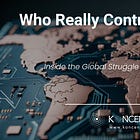Apple’s China Gamble: When Market Logic Turns Into Geopolitics
Reflections on Patrick McGee’s Apple in China through a technopolitics lens.
Patrick McGee’s Apple in China is much more than the story of Apple. It is the story of globalization’s rise and unraveling.
Reading it through my technopolitical lens, three themes really stand out: cultural blindness, structural dependency, and the geopolitical reckoning now underway.
1. California hubris, global consequences
Apple’s story is deeply California-centric: innovation as a West Coast export, the rest of the world as a production line. China was initially treated as a means to an end rather than a market in its own right, before being rebranded as the indispensable partner.
That cultural asymmetry echoes what I experienced myself while living in Canada when a US colleague would ask me what time it is in Toronto while sitting in New York... (same dah!)... or why is the Canadian Thanksgiving not on the same day as the US one... (I'll let you find this one out!). Now I live in Singapore and they think I live in China... sigh..
Specifically the story about the first Apple Store opening in China is very telling: the lack of interest and genuine lack of cultural awareness are absolutely mind boggling.
But the bottom line is that Apple’s relentless design and innovation were only possible because others absorbed the costs: Chinese labor, often under brutal conditions; families broken by the factory system; even child labor.
In short: Apple captured the margin, China captured the know-how or like McGee quoted from an Apple’s employee: "We've trained a whole country, and now that country is using it against us".
I find it incredible that most Chinese suppliers were willing to take Apple's orders at cost or with very little margin because they saw value in the learning. The proof: Apple is credited to have trained close to 28M works in China since 2008 ("more people than the entire labor force of California")!
This dynamic has produced unintended consequences: Apple trained its future competitors. Like Tesla today, Apple’s reliance on Chinese suppliers not only created its products but also seeded national champions capable of turning the tables; now a threat to US industrial independence.
2. Market logic becomes national power
What really struck me is how incremental business decisions - each rational in isolation - coalesced into such a fragile dependency. In particular, once the iPhone became the company’s exponential growth engine, scale, customization, and cost pressure narrowed Apple’s options. Only China could deliver.
In fact, to make it happen Apple has invested a total of $55 billion per year. Consider “America’s spending $13.3 billion over four years to spur post–World War II development in sixteen European countries—or $131 billion in 2016 dollars.” highlights McGee.
Similar to Chris Miller's Chip War demonstrating the emergence of fab-less chip companies who would focus on the design while production was outsourced to contract manufacturers in Asia. The incredible scale and machinery cost needed to make such business profitable meant to decouple design and manufacturing, the same way Apple "Designs in California" and "Manufactures in China".
In fairness it was a context of active globalisation and enthusiasm; trying to seed democracy in China via trade. It is quite clear from Apple's engineers quoted in the book; that never ever were geopolitics a consideration in these decisions.
Even today, most people consider technology and geopolitics independently: I am a firm believer this is changing and companies entire software stack is at risk of geopolitical interferences (not just supply chains, but rather software supply chain).
However it will now become a textbook example of what I would describe as weaponized interdependence : when the pursuit of efficiency morphs into geopolitical vulnerability. Market forces alone built a formidable competitor: not just Huawei or Xiaomi, but the Chinese state itself, armed with industrial policy and long-term planning (Made in China 2025, dual circulation).
Trump’s sanctions on Huawei temporarily shielded Apple, but also pushed Beijing to accelerate its quest for self-reliance .
Short-term political cycles in Washington met disciplined industrial strategy in Beijing. And it's now ripe for collision.
3. Apple’s narrowing strategic horizon
Today, Apple’s empire rests overwhelmingly on one product and one geography: in fiscal year 2024 iPhone accounted for 51% of Apple’s total revenue and China alone about 17%.
With no “next iPhone” in sight, margins have been propped up, not volumes expanded. App Store and services business, once a diversification play, are under antitrust fire.
“In 2016, when iPhone margins were 33 percent, Chinese rivals Oppo, Vivo, and Xiaomi were earning 7 percent, 6 percent, and 2 percent margins, respectively”. What McGee calls the “Apple Squeeze”.
Prospective scenarios I can think of:
Forced exit from China: Apple would have to embrace roboticized “dark factories” to keep costs low; reducing design complexity and ceding the innovation edge to local firms.
Dual footprint: iPhone production remains in China, but new categories (wearables, spatial computing) shift elsewhere; if they ever achieve scale.
Stagnation: Without a new killer product, Apple shrinks into a high-margin but narrow business; submerged by high-end Chinese competitive products.
Attempts to shift to India highlight the challenge: most operations there remain limited to final assembly, test, and pack, with components flown in from China and overseen by Taiwanese firms like Foxconn and Wistron. India is ramping production at barely a tenth of the speed China achieved a decade earlier.
Apple’s cash on hand was $162.3 billion as of March 30, 2024 (Mottley Fool).
But in each case, Apple’s war chest buys time, but not immunity...
4. The toll on people
It's also interesting to note how little has been written about the incredible toll on people Apple had: its own teams because of the pressure to push the boundaries and the trips to China; and of course the millions of Chinese workers themselves.
As the Chinese scholar Qin Hui observed, the country’s competitiveness was built on “low wages, low welfare, and low human rights.”
Apple’s success in China was not only built on design ingenuity and scale, but also on the invisible sacrifices of millions of workers.
Apple’s brand equity, secretive culture and tight control of the narrative though has been so powerful that most of us have been looking elsewhere: exciting products, great shopping experience, friendly customer service, great profits and stock prices!
Behind every sleek iPhone was a system of labor that demanded relentless discipline: young migrants leaving their families behind to live in regimented dormitories, working exhausting shifts to meet Cupertino’s unforgiving production schedules.
The Foxconn suicides in the early 2010s briefly exposed this hidden cost to the world, but they were only the most visible symptom of a deeper malaise. Divorce, broken families, and even child labor became structural features of a model where entire provinces were reorganized around the needs of Apple’s supply chain.
California captured the profit and prestige, while China absorbed the pain.
This asymmetry turned the iPhone into both a global object of aspiration and a symbol of inequality.
Today, as wages rise and labor conditions tighten in China, Apple struggles to replicate this model elsewhere. The human cost was never incidental; it was the very foundation of Apple’s scale. And that makes it Apple’s most fragile legacy.
5. The larger technopolitics canvas
McGee’s account reflects a broader geopolitical shift. What once looked like benign globalization now appears as strategic naivety.
By 2022, Apple was even partnering with YMTC, a state-backed memory-chip maker central to Beijing’s Made in China 2025 plan, despite Washington considering the firm for blacklisting.
Warren Buffett (Apple’s largest shareholder) cut his stake in both TSMC and Apple citing these geopolitical risks. These examples underline just how hard it will be for Apple to chart an independent course.
Looking at the key power-techno-blocks:
United States is weaponizing technology and finance (CHIPS Act, Cloud Act, export controls) .
China leverages scale, state capitalism, and "Chūhǎi" (出海) (a term that literally means "going out to sea,") refers to expansion into Southeast Asia and the Global South, where its firms are no longer just subcontractors but system-builders; they offer both scale and capabilities.
Europe risks becoming a “digital referee” rather than a player, regulating Big Tech while failing to build alternatives. Initiatives like EuroStack are late, but necessary if Europe wants to escape total dependency.
Global South becomes the real battleground: markets like Southeast Asia, Africa, and Latin America are the new laboratories where US and Chinese models compete, often leaving little room for local sovereignty.
6. Looking ahead
The Apple story crystallizes a deeper paradox: the same interdependence that made globalization efficient has become a vulnerability in an era of multipolar rivalry. If the 2000s were about cost efficiency, the 2020s and 2030s are about resilience, redundancy, and sovereignty in a fragmented world.
The question is not just whether Apple can reinvent itself, but whether Western democracies can sustain innovation without reproducing the dependencies that hollowed out their strategic autonomy.
Final words
My take: McGee’s book is compelling because it is not only about Apple. It is about the unintended geopolitics of capitalism and the short lived democratic cycles in the background, leaving little place for long term execution.
The company’s dependence on China is the mirror of the West’s dependence on authoritarian efficiency. What struck me most is how quickly “rational” business choices add up to geopolitical weakness.
The lesson for leaders today: don’t confuse market logic with strategic security.
Decisions about supply chains, data, or AI training are no longer just operational; they are technopolitical choices that shape sovereignty, resilience, and power.
Checkout McGee’s website for more info: https://patrick-mcgee.com
Questions? Comments? I’d love to hear from you:
Thanks for reading!
Damien
I am a Senior Technology Advisor who works at the intersection of AI, business transformation, and geopolitics through RebootUp (consulting) and KoncentriK(publication): what I call Technopolitics. I help leaders turn emerging tech into business impact while navigating today’s strategic and systemic risks. Get in touch to know more damien.kopp@rebootup.com






You have a typo here in the second Chinese character: "Chuhai" (出去)
You can find the right one using the hanyupinyin.
Anyway - Apple is facing so many problems these days, starting at the top with Product and invention, and ending with the supply chain.
Still super-valuable though, and hard to see them toppled
But it only takes a few crises...